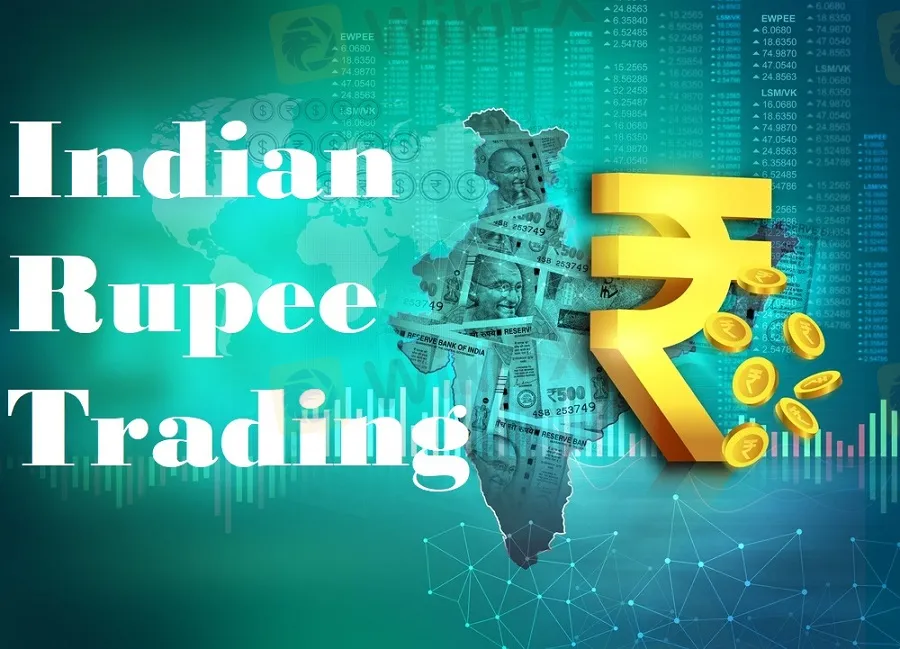简体中文
繁體中文
English
Pусский
日本語
ภาษาไทย
Tiếng Việt
Bahasa Indonesia
Español
हिन्दी
Filippiiniläinen
Français
Deutsch
Português
Türkçe
한국어
العربية
Indian Rupee Trading - Complete Guide to Trading the INR
Abstract:Against the backdrop of the rise of the Eastern economic powerhouse, India's vast workforce provides a unique advantage for the country's economic development. Therefore, the Indian Rupee still holds significant investment potential.

Over the past decade, India has witnessed a substantial increase in economic growth, leading to a significant rise in the popularity of Indian Rupee trading. However, despite the robust economic expansion, the Indian Rupee has consistently experienced a depreciating trend relative to other major currencies. This has raised doubts among investors regarding the currency's investment value. Nevertheless, the undeniable advantage of India's vast workforce continues to present substantial investment potential for the Indian Rupee.
This article aims to provide a detailed guide for novice forex traders interested in trading the Indian Rupee. By reading this article, you will gain insights into the determination of the Indian Rupee exchange rate, factors influencing its pricing, and the pros and cons of trading the Indian Rupee. Whether you are located in India or not, if you have an interest in the Indian Rupee, this article will be beneficial. Are you ready? Continue reading to find answers!
Overview of the Indian Economic Situation
India's economic industry is diversified, covering agriculture, industry, textiles, and the service sector. Approximately two-thirds of the population still relies directly or indirectly on agriculture for their livelihoods. Over time, the importance of the service sector has grown, contributing to over 50% of the Gross Domestic Product (GDP). India ranks as the world's fourth-largest automotive industry, second-largest steel-producing nation, second-largest coal-producing country, second-largest cement-producing country, and the third-largest in terms of electricity generation. Additionally, it stands out as one of the world's fastest-growing e-commerce markets.

According to the Purchasing Power Parity (PPP) data published by the International Monetary Fund (IMF), India is the world's third-largest economy. Calculated in terms of GDP with the U.S. dollar as the currency unit, in 2022, India surpassed the United Kingdom with an economic total of $3.5 trillion, securing its position as the fifth-largest economy globally, maintaining a consistent high growth rate. However, the substantial population also poses challenges, leading to economic disparities in India.
Considering various factors, including assessments from international institutions like the IMF and the World Bank, there is optimism regarding India's development potential and prospects. India has emerged as one of the world's fastest-growing emerging market economies.
Foundation of the Indian Currency Market
As widely recognized, the currency market is esteemed as one of the world's largest financial markets. It serves as a platform for the buying and selling of a nation's currency. This market accommodates a diverse range of participants, including hedge funds, banks, central banks, corporations, and investors, resulting in high trading volumes. Moreover, currency trading often involves high leverage, making even slight fluctuations capable of leading to significant profits or losses. The currency market operates 24 hours a day, five days a week.
In the context of India, active currency trading hours are from 9:00 AM to 5:00 PM, Monday to Friday, during which the Reserve Bank of India (RBI) is operational. Cross-currency trading extends until 7:30 PM. The currency market comprises two primary types: the spot or cash market and the derivatives market. In India, currency trading occurs through the derivatives segment, with currency futures and options primarily traded on the National Stock Exchange (NSE) and the Bombay Stock Exchange (BSE). These exchanges provide platforms for trading a total of seven currency pairs, including USD/INR, EUR/INR, GBP/INR, JPY/INR, EUR/USD, GBP/USD, and USD/JPY. Additionally, traders can engage in currency trading through online platforms offered by brokers.
Characteristics of the Indian Rupee
The Indian Rupee (INR) is the official currency of India, issued and managed by the Indian government and the Reserve Bank of India (RBI). The symbol for the Indian Rupee is ₹, officially adopted in 2010, and its ISO 4217 code is INR.
India declares the adoption of a floating exchange rate system, where the exchange rate of the Indian Rupee against another currency is influenced by various market indicators such as demand and supply. For instance, if there is an increased demand for the Indian Rupee in the market, as the currency becomes more popular and scarce, it should appreciate in value.

Since the beginning of 2023, the exchange rate of the Indian Rupee against the US Dollar has been fluctuating within a narrow range of 81 to 84 Rupees for 1 US Dollar. The International Monetary Fund (IMF) assessed this performance and suggested a shift in the Indian Rupee's exchange rate from a market-driven floating system to a managed system controlled by the government. The IMF report emphasized that exchange rate flexibility should serve as the primary shock absorber, with interventions limited to addressing disorderly market conditions. However, during the period covered by the report, the Rupee-to-Dollar exchange rate fluctuated within an extremely narrow range, indicating that foreign exchange interventions (FXI) might have exceeded the necessary levels for addressing disorderly market conditions.
The Reserve Bank of India disagrees with this assessment, considering it to be limited in scope. They argue that with a long-term perspective of 2 to 5 years, such evaluations would not be made when assessing the Indian economy.
In conclusion, how the Indian authorities handle exchange rate issues in the future will directly impact the trajectory of the Indian Rupee, influencing its attractiveness to currency pair investors. Currently, there is speculation about whether the divergence between the IMF and Indian authorities will have repercussions on India's markets and exchange rates in 2024.
Opportunities and Challenges in Trading the Indian Rupee
Opportunities
High Volatility
The exchange rate of the Indian Rupee exhibits relatively high volatility, providing profit opportunities for short-term traders. Volatility often creates price fluctuations, offering traders timing opportunities to enter and exit the market.
Emerging Market Opportunities
Being a currency from an emerging market, trading the Indian Rupee may be influenced by global economic development and India's economic growth. Investors can profit by accurately assessing these factors.
Interest Rate Differentials
Interest rate differentials play a crucial role in forex trading. India's interest rates may differ from those of other countries, presenting investors with arbitrage and profit opportunities.
International Trade Opportunities
As India's position in international trade continues to rise, currency trading related to India may present opportunities due to trade activities. Monitoring India's trade data and international relations can help discern market trends.

Challenges
Liquidity Issues
The liquidity of the Indian Rupee is relatively lower compared to some major currencies. This may lead to increased spreads in the market, posing challenges for executing trades.
Political and Economic Uncertainty
As an emerging market, India may be susceptible to political and economic uncertainties. Sudden events or policy changes can result in market volatility, increasing trading risks.
Forex Regulations
In the past year, the Indian government implemented some forex control measures, including restrictions on capital flows. This may affect the performance of the Indian Rupee in the international market.
Currency Depreciation Risk
Currency depreciation risk is common for currencies from emerging markets. The value of the Indian Rupee may be influenced by factors such as inflation and trade imbalances.
Different Market Time Zones
Due to India's different time zone compared to other major financial centers, traders may need to participate in the market at various times, adding complexity to trading strategies.
Steps to Start Trading the Indian Rupee

Learn the Basics
Before traders embark on currency trading, it's crucial to have a solid understanding of the market and various strategies used for decision-making. This involves learning fundamental terms like pips, lots, and spreads, then progressing to more advanced concepts such as technical analysis, fundamental analysis, etc. Traders can access abundant educational resources online, including courses and articles, and also participate in offline events like seminars.
Choose a Broker
When selecting a broker, traders should consider factors such as regulatory information, trading and non-trading fees, customer support, etc.
For Indian residents, it's essential to look for brokers licensed and regulated by the Securities and Exchange Board of India (SEBI) while providing a reliable trading platform and user-friendly interface. Another crucial factor in broker selection is those offering competitive fees and low spreads, as these directly impact profits.
Open an Account and Fund It
After choosing a suitable broker, traders should fill out an online application and provide necessary KYC documents (such as identification and address proof) to open a trading account. The broker will then verify this information and activate the account upon completion of the verification process. Once the account is active, traders need to deposit the required funds, which depend on the broker's minimum deposit requirement.
Initiate Trades
With everything in place, traders can select suitable currency pairs in the market for trading. Trades can be executed by placing buy or sell orders. Traders can also set stop-loss orders to limit losses and take-profit orders to lock in profits. During the trade execution process, traders should closely monitor market news and events that may impact the currency market, dynamically adjust their trading strategy, and avoid emotional trading.
FAQs

Is Currency Trading Legal in India?
Currency trading is legal in India and is regulated by the Reserve Bank of India under the Foreign Exchange Management Act. Indian residents can trade approved currency pairs through authorized brokers or agents. However, there are restrictions and regulations (such as transaction amount limits and the requirement to use Indian Rupees for margin payments), and traders must adhere to these to avoid legal issues.
Why Should I Trade the Indian Rupee?
Trading the Indian Rupee can offer opportunities for faster and more significant profits due to its potential for volatility. Additionally, forex trading is more accessible than ever, allowing retail investors easy access to online brokers, trading charts, and analysis tools.
What Factors Affect the Price of the Indian Rupee?
Numerous factors can influence the price of the Indian Rupee, and any investor involved in trading it should closely monitor these. Key considerations include central bank policies, economic health, GDP growth, and the political climate.
Bottom Line
Indian Rupee trading is gaining attention, benefiting from the rise of the Eastern economies and the unique advantage provided by its massive workforce. Despite the relative depreciation of the Rupee, robust economic growth continues to present opportunities for investors.
For beginners, acquiring fundamental knowledge of forex trading is the first step in starting to trade the Indian Rupee. Traders should also continuously learn and update their trading strategies to seize opportunities arising from market volatility and interest rate differentials. Meanwhile, investors should not overlook significant challenges, including political uncertainty, associated with the Indian Rupee as one of the representative currencies of emerging markets.
In conclusion, as the role of the Indian Rupee expands in the evolving global economy, ongoing learning and adaptation to market changes are crucial for traders interested in this dynamic currency.
Disclaimer:
The views in this article only represent the author's personal views, and do not constitute investment advice on this platform. This platform does not guarantee the accuracy, completeness and timeliness of the information in the article, and will not be liable for any loss caused by the use of or reliance on the information in the article.
Read more

InterTrader Exposed: Traders Report Unfair Account Blocks, Profit Removal & Additional Fee for Withd
Does InterTrader block your forex trading account, giving inexplicable reasons? Does the broker flag you with latency trading and cancel all your profits? Do you have to pay additional fees for withdrawals? Did the UK-based forex broker fail to recognize the deposit you made? Does the customer service fail to address your trading queries? In this InterTrader review article, we have shared such complaints. Read them out.

Grand Capital Doesn’t Feel GRAND for Traders with Withdrawal Denials & Long Processing Times
The trading environment does not seem that rosy for traders at Grand Capital, a Seychelles-based forex broker. Traders’ requests for withdrawals are alleged to be in the review process for months, making them frustrated and helpless. Despite meeting the guidelines, traders find it hard to withdraw funds, as suggested by their complaints online. What’s also troubling traders are long processing times concerning Grand Capital withdrawals. In this Grand Capital review segment, we have shared some complaints for you to look at. Read on!

ADSS Review: Traders Say NO to Trading B’coz of Withdrawal Blocks, Account Freeze & Trade Issues
Does ADSS give you plenty of excuses to deny you access to withdrawals? Is your withdrawal request pending for months or years? Do you witness account freezes from the United Arab Emirates-based forex broker? Do you struggle to open and close your forex positions on the ADSS app? Does the customer support service fail to respond to your trading queries? All these issues have become a rage online. In this ADSS Broker review article, we have highlighted actual trader wordings on these issues. Keep reading!

INGOT Brokers Regulation 2025: ASIC vs Offshore License - What Traders Must Know
Explore INGOT Brokers regulation in 2025: Compare their ASIC and Seychelles FSA licenses, understand trader protection levels, and learn about potential risks in this detailed guide.
WikiFX Broker
Latest News
Mitrade Arabic Platform Targets MENA Gold Trading Boom
Israeli Arrested in Rome Over €50M Forex Scam
New FCA Consumer Alert 2025: Important Warning for All Consumers
EmiraX Markets Withdrawal Issues Exposed
Consob Targets Political Deepfake “Clone Sites” and Unlicensed Platforms in Latest Enforcement Round
WikiEXPO Global Expert Interviews: Gustavo Antonio Montero: ESG in Finance
Scam Alert: GINKGO-my.com is Draining Millions from Malaysians!
INGOT Brokers Regulation 2025: ASIC vs Offshore License - What Traders Must Know
Is Upforex Safe or a Scam? A 2025 Safety Review Based on Facts
Polymarket Onboards First US Users Since 2022 Shutdown: Beta Relaunch Signals Major Comeback
Currency Calculator



